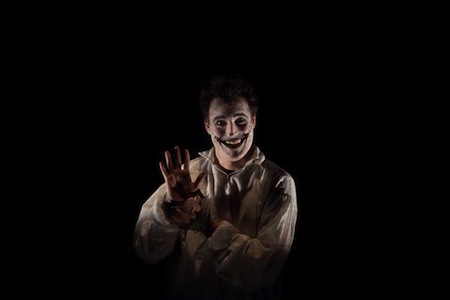Let's Put a Smile on that Face
The Man Who Laughs
Urban Stages
259 W. 30th Street
New York, N.Y.

Walk into Urban Stages, a small theater in New York City, and a carnival vendor hands you a free bag of popcorn for the show. For half an hour you're entertained by a singer and pianist at the front of a stage designed to look like a Golden Age movie theater. Another pianist, this one in a suit, then comes out, bows, and starts to play the background music to The Man Who Laughs, a 1928 masterpiece of German Expressionism starring Conrad Veidt, based on Victor Hugo’s 1869 novel. Thus begins the stage adaptation of The Man Who Laughs, not It is very unusual to watch a play designed as a silent film, with no dialogue and the only sound the tingling keys of the piano.
The Stolen Chair Theater Company is famous for unusual plays, and The Man Who Laughs, which opened last week, is certainly in that tradition. If you love silent movies, you'll love The Man Who Laughs.
Playwright Kiran Rikhye combined Hugo’s novel and the screenplay of the 1928 movie (there was also a short 1909 silent film) to come up with his own version of the story. All of the dialogue is on cue cards projected on to top rear of the stage, just as in silent films. The performers all over-act in an exaggerated manner, as they did in the silents (which, bringing things full circle, had its roots in the theatrical backgrounds of many early celluoid actors). There are striking close-ups of actors at key moments to highlight the drama, just as there were in silent films. It's quite jarring to step outside the theater to the year 2013 -- and the wall of noise that is Manhattan.
Because it's a play based on a silent film, I felt very uneasy for the first fifteen minutes of the show. It takes that long to adjust to a play without spoken words. Then, after that initiation, I felt very much at ease watching the play -- it's a bit like watching a subtitled foreign film. From that moment on, The Man Who Laughs soars.
The Man Who Laughs, set against the backdrop of Glorious Revolution-era England, is the story of a gang that carves a permanent clown’s smile into the face of a young boy, who carries that grotesque, happy look throughout his life (incidentally, the Joker's smile from the Batman comics was directly visually modelled on Conrad Veidt in the 1928 film version of The Man Who Laughs). No one knows when he is sad because he is always smiling. Permanent happiness is good, though, or is it?
The boy, Gwynplaine, and a baby girl he rescued, Dea, are taken in by Ursus, a carnival ventriloquist, who makes them a freak show act. The girl who cannot see Gwynplaine’s smiling face, so she falls in love with him.
Their life at the carnival is interrupted when a wealthy Duchess, Josiana, decides to bring Gwynplaine home. The beautiful duchess has been surrounded by handsome suitors all of her life, so she is intrigued by a hideously deformed man. They are discovered in her bedroom by her lover and the plot then takes a dozen twists and turns.
Silent movies, with no dialogue, depended on fine acting and directing, and The Man Who Laughs has both. Stancato has done a superb job of turning the little-known novel movie into a solid contemporary drama. He receives good acting from Joan Schultz as Gwynplaine (the boy) and Dave Droxler as Gwynplaine (the man), Jon Froehlich as Ursus, Molly O’Neill as Dea, Rebecca Whitehurst as the cavorting Duchess Josiana, and Raife Baker as David Dirry-Moir, her lover.
Despite a slow start, The Man Who Laughs worth the visit, popcorn, piano, dialogue cards and all.
PRODUCTION: Sets: Michael Minahan, Costumes: Julie Schworm, Lighting: Daniel Winters, Dramaturgy: Emily Otto, Makeup: Stephanie Cox-Williams, fight Choreography: Noah Schultz. The play is directed by Jon Stancato.
